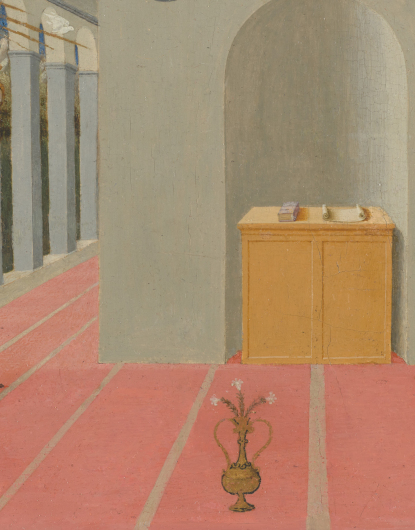Masterpieces from the Lanckoroński Collection: A Second Look
On the 30th Anniversary of Professor Karolina Lanckorońska’s Gift
October 25, 2024 – February 2, 2025
Thirty years ago, in October 1994, paintings donated by Professor Karolina Lanckorońska arrived at Wawel. They were part of a collection of Italian paintings, mainly from the 15th and 16th centuries, gathered by her father Karol in the Lanckoroński family palace in Vienna. The Wawel collection, supplemented by the Donator in 2000 with the painting Jupiter Painting Butterflies by Dosso Dossi and enlarged by several works donated under her will in 2002, is exhibited in the halls on the first floor of the Castle.
The exhibition presents three Italian paintings that were an integral part of Karol Lanckoroński's Viennese collection, and after World War II were sold by the family to American and European collections.
October 25, 2024 – February 2, 2025
Thirty years ago, in October 1994, paintings donated by Professor Karolina Lanckorońska arrived at Wawel. They were part of a collection of Italian paintings, mainly from the 15th and 16th centuries, gathered by her father Karol in the Lanckoroński family palace in Vienna. The Wawel collection, supplemented by the Donator in 2000 with the painting Jupiter Painting Butterflies by Dosso Dossi and enlarged by several works donated under her will in 2002, is exhibited in the halls on the first floor of the Castle.
The exhibition presents three Italian paintings that were an integral part of Karol Lanckoroński's Viennese collection, and after World War II were sold by the family to American and European collections.

The J. Paul Getty Museum in Los Angeles has a panel depicting Saint Andrew by Masaccio, one of the most important painters of the Italian Quattrocento, presented at the Wawel exhibition. The painting comes from a now-dispersed retable that the artist made in 1426 for the church of Santa Maria del Carmine in Pisa, parts of which are located in the National Gallery in London, the Gemäldegalerie in Berlin and the Mueso Nazionale di Capodimonte in Naples, among others. Karolina Lanckorońska used the funds obtained from the sale of the painting in 1979 to save the Polish Library in Paris.
Tommaso di Giovanni Guidi, detto Masaccio (1401–1428 or 1429)
Saint Andrew, 1426
tempera, gilt, wood, 52.4 × 32.1 cm
J. Paul Getty Museum, Los Angeles
inv. no. 79.PB.61
Digital image courtesy of Getty’s Open Content Program
Tommaso di Giovanni Guidi, detto Masaccio (1401–1428 or 1429)
Saint Andrew, 1426
tempera, gilt, wood, 52.4 × 32.1 cm
J. Paul Getty Museum, Los Angeles
inv. no. 79.PB.61
Digital image courtesy of Getty’s Open Content Program

The Annunciation, a painting that Karol Lanckoroński bought as a work by Fra Angelico in 1893, is currently in the Fine Arts Museum of San Francisco. Before it was associated with the work of the Florentine artist Francesco di Stefano, known as Pesellino, it was listed as the work of an anonymous painter called the “Master of the Lanckoroński Annunciation”. In this way, the name of a collector was established, who at the end of the 19th century – as one of the few in Europe at that time – collected early Italian painting.
Francesco di Stefano detto Pesellino (1422–1457)
Annunciation, circa 1445
tempera on wood, 25.4 x 33.1 cm
Fine Arts Museums of San Francisco, Gift of The de Young Museum Society
inv. no. 54.3
Photograph by Randy Dodson, courtesy of the Fine Arts Museums of San Francisco
Francesco di Stefano detto Pesellino (1422–1457)
Annunciation, circa 1445
tempera on wood, 25.4 x 33.1 cm
Fine Arts Museums of San Francisco, Gift of The de Young Museum Society
inv. no. 54.3
Photograph by Randy Dodson, courtesy of the Fine Arts Museums of San Francisco

The third work is an image of Saint Ansan, a martyr living in the time of Emperor Diocletian, one of the patrons of Siena. In the collection of the Fondazione Cavallini Sgarbi from Ferrara, it is considered a work of Bartolomeo di David, a Sienese artist active at the beginning of the 16th century.
Bartolomeo di David (1482–1545/1546)
Saint Ansan (Ansanus), circa 1535
oil on wood, 146 x 62.8 cm
Ferrara, Fondazione Cavallini Sgarbi
photo Luca Gavagna – le immagini
Bartolomeo di David (1482–1545/1546)
Saint Ansan (Ansanus), circa 1535
oil on wood, 146 x 62.8 cm
Ferrara, Fondazione Cavallini Sgarbi
photo Luca Gavagna – le immagini
The second edition of the exhibition “Masterpieces from the Lanckoroński Collection” will certainly allow us to better imagine the nature and significance of the Lanckoroński Viennese collection, which also included Paolo Uccello's painting Saint George and the Dragon from the collection of the National Gallery in London, presented at Wawel two years ago.




 Patron of the Wawel Royal Castle
Patron of the Wawel Royal Castle
 Strategic Partner of the Wawel Royal Castle
Strategic Partner of the Wawel Royal Castle
 Education Patron of the Wawel Royal Castle
Education Patron of the Wawel Royal Castle
 Partner of the Wawel Royal Castle
Partner of the Wawel Royal Castle











